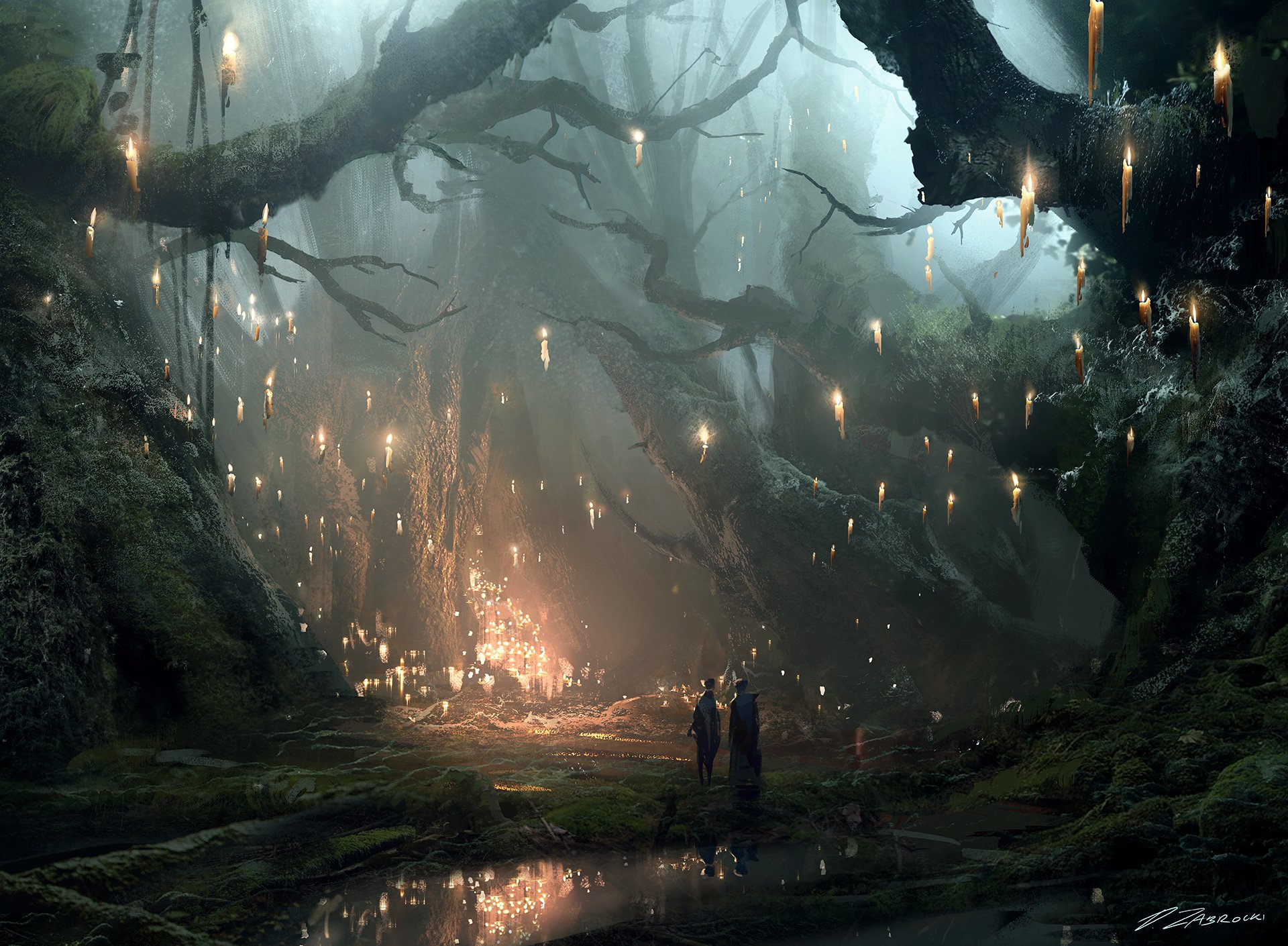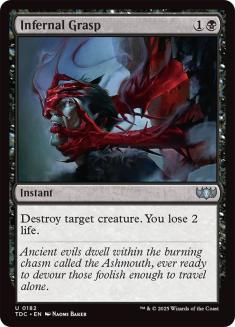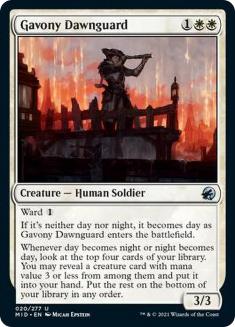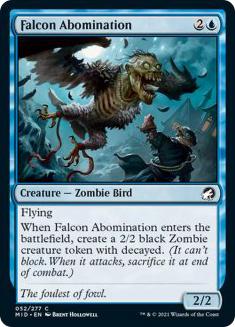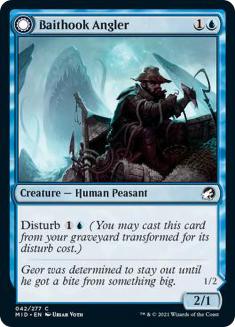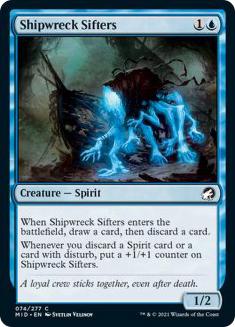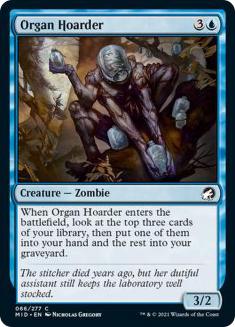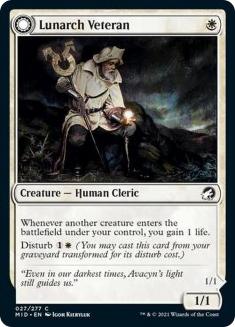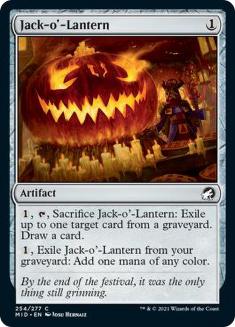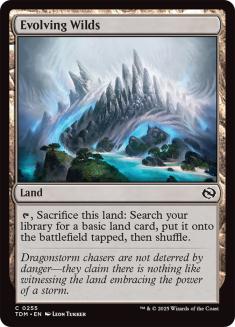Drafting is self-correcting.
When something is the best, everyone fights over it, and they each get only part of that power. But it’s only self-correcting if everyone knows what’s best. This has led to debates about whether drafting on Arena really is self-correcting, particularly because Draft pods on Arena pull any players regardless of rank, so highly skilled and informed players often end up drafting with less skilled and less informed players, who might not fight them for the best colors and cards.
In my experience, it’s felt like Arena is slow, but does eventually catch up. For the first few weeks of Innistrad: Midnight Hunt Limited, it felt very easy to reliably draft strong blue and/or black decks, but more recently, I’ve felt like any time I end up in Dimir, I’ll probably have to fight for playables while passing lots of red and green cards around the table at the end of the pack.
So how should your behavior change as a format starts to correct itself?
Do you try to level it by putting yourself in less popular colors? You can, but it always feels like a risky gambit to me. I think red in this format can support around one good deck per table. If you take a stand early and draft red cards from the beginning, you might claim the color to yourself, but if someone else is fighting you for it, I think it’s hard to get a great deck, and it feels too likely to me that someone will. If I’m going to draft red, I want to do it because I’m getting passed red cards and feel like it’s sufficiently open.
I like to start by taking the best cards, but I also know that sometimes the colors I’m in can be contested enough that I have to branch out into another color, which may or may not involve abandoning a color I’ve drafted.
So how do you do it? How do you draft in such a way that you can navigate out of a color that’s closed and into one that’s open? Alternatively, how do you use all the cards you’ve drafted?
Probabilistic Card Assessment
With every pick, your goal is to maximize the expected quality of your deck. You don’t know how much better a card that you take early will make your deck, because you don’t know how well the cards you end up with will use it. What you’re trying to do is approximate the card’s range and assign probabilities to how likely each possible strength in that range is. Of course, most people do this intuitively rather than numerically.
A “splashable card” — generally one without two pips of the same color of mana in its casting cost — is a more reliable first pick than a card that you can only play if you’re solidly in a color, because you’re more likely to play it, so you’re more likely to realize the higher end of its potential.
If I opened Infernal Grasp and Gavony Dawnguard in my first pack, and I thought they were of a similar power level, I’d weigh how likely each is to make my deck. Gavony Dawnguard requires two white mana reasonably early in the game, so it’ll perform much worse if I don’t have a lot of Plains in my deck, while Infernal Grasp is a card I can play with only a few Swamps; when I do, I’ll have to estimate it as a slightly less powerful card because I won’t always be able to cast it, but it’ll still likely be better than my next best card.
But I also need to factor in my color preferences. How often do I expect to end up drafting white and how often do I end up drafting either black or a deck that would splash Infernal Grasp? These questions help me narrow in on the expected value over replacement for each pick to decide which card to take.
Each pick after my first pick uses the same logic, but with emergent context based on the cards I’ve already drafted that inform my expected outcomes. If I take the Gavony Dawnguard, when I’m making my second pick, I assign a much higher probability to the chance that I’ll play white cards that I draft.
You can work to use the cards you’ve drafted. You do this by prioritizing their colors or cards that pair well with them strategically. For some cards, you’ll end up working harder to use them optimally than others. Every pick is informed by your previous pick, but it also informs your future picks. What this means is that there’s another factor you need to take into account when considering the value of taking a particular card, which is how much value you’ll have to give up in future picks to make it work.
For example, I think Falcon Abomination is a stronger card than Baithook Angler, but if I have Shipwreck Sifters, I want a lot of Baithook Anglers and other creatures with disturb to discard to them. That means that when I consider drafting a Shipwreck Sifters, I need to ask myself how likely it is that the Shipwreck Sifters will live up to its potential, but also how much I might have to give up to meet that potential. If I intend to take Baithook Angler over Falcon Abomination if it comes up in a future pick, I’m more likely to realize the higher end of Shipwreck Sifters’s range, but I’m also more likely to have to give up value by taking the weaker Baithook Angler over the stronger Falcon Abomination, so while the Shipwreck Sifters has a higher expected value, it also has a higher expected cost.
This is the core of why I believe different picks are right for different players. If I hate every green common, and will almost certainly look to pivot out of green even if I first-pick a good green card if given a chance, then a card like Augur of Autumn, a powerful card, might not be a good first pick for me because I’m very unlikely to play it because I won’t take other green cards. I’m not willing to pay the costs I’d have to pay in future packs, taking what I think are weaker green cards over stronger cards of other colors, so I would assign a low chance that I play it.
It’s easiest to discuss first picks, but again, the same reasoning applies to any pick. Imagine a draft in which you took Organ Hoarder first and second picks, then get passed a pack without any strong blue cards and take a Lunarch Veteran. Fourth pick you’re passed a pack where the best cards are Gavony Silversmith and Diregraf Horde. Diregraf Horde is a stronger card, but it puts you into a third color, which will create some tension in your draft.
You likely won’t use all the cards you’ve drafted and you might spend a few more picks on a color you don’t use as you attempt to figure out which colors you’re playing. However, fourth pick is a little late to see a Diregraf Horde, so it might be a bit of a signal that black is open, and it might be harder to move in later if you pass this and it is open, and if you do move in, it might be more contested in the next pack.
In this case, I would take the Diregraf Horde, but I wouldn’t consider this a pivot into black. I haven’t chosen colors at this point, I’m just feeling out the table. Maybe I’ll play black, maybe I’ll play white, and there’s some chance I’ll play both of neither, but I think my deck improves by a lot in the event that I’m in a seat that can draft black will, while I think the Gavony Silversmith would only slightly improve my Azorius-based deck.
The biggest mistake that I think people make is feeling pressure to choose their colors. They think they need to play exactly two, and there should be some point where they commit to what those are. Sometimes they let themselves change colors, but often when they do that, it’s still too decisively, rather than gradually or experimentally. You want your drafting to be fluid and open-minded; for each pick, you want to be creative in imagining all the different ways you could use it to assess how likely each of them are and how strong it would be in each, rather than evaluating your deck only in the context of expectations you had based only on your previous picks.
The worst version of this mistake, incidentally, comes when a player feels pressure to choose a second color because they only have one color. If you’re only solidly in one color, that’s a great spot to be because it means you have the most optionality, so you can easily take advantage of anything that comes your way. Some drafters panic in this spot because they don’t know what to expect and try to take something to solidify themselves in a second color to anticipate their archetype, but the longer you can put this off, the better.
That was kind of a long tangent, but it’s a philosophy of drafting I’ve been wanting to write out for a long time. Anyway, it’s important to understand because it’s how you should navigate finding your lane in a draft, which is very closely related to choosing your colors.
When you’re drafting flexibly, you’ll often end up with a few cards outside of the colors you end up drafting, so the question is whether you should abandon them or try to play them.
When to Splash
The broadest and most important guideline is this: the more aggressive your deck is, the less you should be willing to splash. If you know that you’re drafting an aggressive deck, don’t give much thought to using off-color cards you’ve picked up, and when assessing the value of a card you might take that’s outside of your colors, assign a very low probability to the chance that you end up splashing it, and instead only consider its value to be rooted in the possibility that you end up strongly diverging from the path you’re on.
If your deck is expecting to play longer games, you can splash much more freely, which means you’ll want to prioritize cards that help you do that even before you have cards you want to splash, just to open up your optionality later in the draft.
Eccentric Farmer and Evolving Wilds, particularly the two of those cards paired together, are the best fixing available in the format for truly ambitious manabases, but Evolving Wilds isn’t always better than Jack-o’-Lantern if you’re just trying to splash a single card. That depends on how many cards you expect to mill, since milling allows Jack-o’-Lantern to fix your mana even when you don’t draw it.
To expand on this, neither is the “better” piece of fixing, they have different strengths and weaknesses. Most importantly, you don’t need to draw Jack-o’-Lantern to benefit from it, but it can only help you once. This means that the more you mill yourself, the stronger Jack-o’-Lantern is, while the more cards you’re splashing, the stronger Evolving Wilds is because the land it finds can cast all the cards of your splash color.
Evolving Wilds and Jack-o’-Lantern are both great cards to pick up cheaply if you’re drafting a slower deck just to be prepared to splash something later on. Crossroads Candleguide can technically help you out with a splash, but I think it’s weak enough that I generally don’t take it speculatively to enable that, but I might take it for that purpose if I know that I’m going to try to splash and my mana’s looking bad.
Conveniently, a lot of the slower decks in this format use the graveyard more. This is convenient because it means all the incentives for splashing are properly aligned. Slow decks want to splash. Decks that set up their own graveyard via milling or discard want to splash because there’s a cycle of gold flashback spells. Decks that set up their own graveyard are better able to splash because they get some amount of fixing from Jack-o’-Lantern and some amount of card selection from cards like Eccentric Farmer, Organ Hoarder, Larder Zombie, and potentially even Otherworldly Gaze.
These aligned incentives make it easy to know when you should look to pull it off and when you shouldn’t. They also tell us that there’s a lot of overlap between decks that splash and graveyard-centric decks, such that if you’re either of those, you should strongly consider becoming the other one.
The other thing that this means, and how this ties into navigating contested colors, is that if you’ve shifted into a new color during a draft, you’ll be more likely to be able to use some of the cards you might otherwise have to abandon if you can pivot into a multicolor graveyard strategy. If I start Azorius or Dimir, and I stop seeing cards for my deck, I’m most likely to look to pivot into green, since I think it’s easy for a Simic deck to splash white or black, allowing me to use the greatest number of the cards I already have.
It’s possible to splash without green, of course. The best options are still Evolving Wilds and Jack-o’-Lantern, paired with any amount of blue card selection, but what about Mardu? Can you draft that in this format?
I personally haven’t, but I have a preference for blue and tend to avoid red in this format, so I wouldn’t often find myself in a position to consider it. I think it is possible, but it’s very rare, since I think each of the pairs of Mardu colors tends to be a fairly aggressive deck, and the colors are bad at enabling graveyards. Your best bet would be Electric Revelation as a way to try to “fix” your mana by discarding cards you can’t cast or digging to find a missing color.
I’d say that if you have a lot of the exact right rares, it might come up, but for the most part, you should only really be looking to splash if you’re playing blue or green. If you’re navigating between Mardu colors, you should expect that any picks you make to hedge between possible colors’/decks you could draft are just to provide optionality to pivot and offer no marginal value as possible splash cards.
I suspect you’d like advice on “Hhow many pieces of fixing do I need to splash X cards?” or something like that. The problem is that those aren’t concrete numbers because a piece of fixing is only a partially coherent concept. Is Evolving Wilds the same as Jack-o’-Lantern? How much of a piece of fixing is Organ Hoarder? What about Larder Zombie? What about Shipwreck Sifters?
I can’t give you a formula. You should ask yourself questions like what turn you expect to have your third color of mana, how much it’s costing you to get that mana, how long you expect your games to go, and how much more powerful the cards you’d splash are than the other cards you’d play instead. If you’re not sure how to answer those questions, then I’d say if it’s close enough that you’re not sure, just try it. See how it feels, how often it works. If nothing else, you’ll get better at knowing whether you should try it again the next time.
As the average drafter becomes more informed, there’s less room to exploit an information gap by playing stronger colors, so we’re forced to turn off autopilot and find the open lane. The good news is, in my opinion, this is when the drafts get a lot more fun, because you’ll have more interesting questions in the draft, and you’ll find yourself playing a wider variety of decks.

